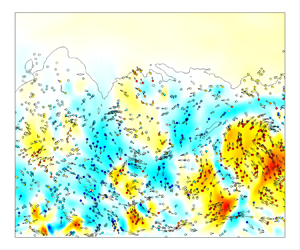No CrossRef data available.
Article contents
Transport of inertial spherical particles in compressible turbulent boundary layers
Published online by Cambridge University Press: 12 August 2024
Abstract

In the present study, we perform direct numerical simulations of compressible turbulent boundary layers at free stream Mach numbers  $2\unicode{x2013}6$ laden with dilute phase of spherical particles to investigate the Mach number effects on particle transport and dynamics. Most of the phenomena observed and well-recognized for inertia particles in incompressible wall-bounded turbulent flows – such as near-wall preferential accumulation and clustering beneath low-speed streaks, flatter mean velocity profiles, and trend variation of the particle velocity fluctuations – are identified in the compressible turbulent boundary layer as well. However, we find that the compressibility effects are significant for large inertia particles. As the Mach number increases, the near-wall accumulation and the small-scale clustering are alleviated, which is probably caused by the variations of the fluid density and viscosity that are crucial to particle dynamics. This can be affected by the fact that the forces acting on the particles with viscous Stokes number greater than 500 are modulated by the comparatively high particle Mach numbers in the near-wall region. This is also the reason for the abatement of the streamwise particle velocity fluctuation intensities with the Mach numbers.
$2\unicode{x2013}6$ laden with dilute phase of spherical particles to investigate the Mach number effects on particle transport and dynamics. Most of the phenomena observed and well-recognized for inertia particles in incompressible wall-bounded turbulent flows – such as near-wall preferential accumulation and clustering beneath low-speed streaks, flatter mean velocity profiles, and trend variation of the particle velocity fluctuations – are identified in the compressible turbulent boundary layer as well. However, we find that the compressibility effects are significant for large inertia particles. As the Mach number increases, the near-wall accumulation and the small-scale clustering are alleviated, which is probably caused by the variations of the fluid density and viscosity that are crucial to particle dynamics. This can be affected by the fact that the forces acting on the particles with viscous Stokes number greater than 500 are modulated by the comparatively high particle Mach numbers in the near-wall region. This is also the reason for the abatement of the streamwise particle velocity fluctuation intensities with the Mach numbers.
- Type
- JFM Papers
- Information
- Copyright
- © The Author(s), 2024. Published by Cambridge University Press





